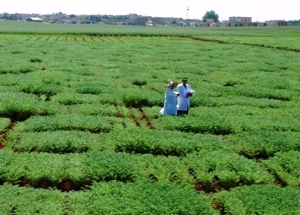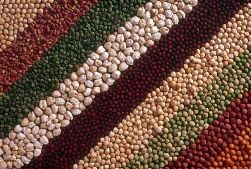CGKB News and events Characterization
Characterization of cultivated chickpea and wild relatives
Contributors to this page: ICRISAT, Patancheru, India (Hari D Upadhyaya, Shivali Sharma, Cholenahalli L Laxmipathi Gowda, Dintyala Sastry, Sube Singh); NBPGR, New Delhi, India (Shyam Sharma); ICARDA, Aleppo, Syria (Ahmed Amri, Kenneth Street, Natalya Rukhkyan), SARC-RIPP, Piestany, Slovak Republic (Gabriela Antalikova); Institute of Plant Genetic Resources ‘K.Malkov’, Sadovo, Bulgaria (Siyka Stoyanova); Department of Primary Industries, Victoria, Australia (Bob Redden); IPK, Gatersleben, Germany (Andreas Börner).
|
Contents: |
Planting and cultural practices for characterization

Evaluation of chickpea germplasm at ICARDA (photo: ICARDA) |
The following are the procedures recommended in the ICRISAT Genebank Manual (Upadhyaya and Laxmipathi, 2009).
Environment
- Chickpea is a dry and cool season crop requiring low ambient relative humidity and absence of rains during flowering and pod maturation.
Soil type
- Soils with good water holding capacity with low acidity/alkalinity are ideal for chickpea (well drained and not very heavy soils are good for chickpea).
- Variable but sandy loam or clay-loam soil with good drainage are preferred.
- Use peat potting mix in pots, alkaline clay in the field, or alkaline clay mixed with potting mix in cages.
Rainfall
- Minimum rain 40-70 cm or irrigation during flowering (heavy rains are harmful to chickpea).
Season
According to the ICRISAT Chickpea Germplasm Catalog: Evaluation and Analysis (Pundir et al, 1988a).
- Post-rainy season (planting in October or November and harvesting in February or March at ICRISAT, Patancheru, Hyderabad, India).
- Autumn planting (mid-November to mid-December) except for spring and cold-susceptible varieties which should be planted in the spring [mid-February to early April in the Central and West Asia and North Africa (CWANA) region].
Plot size
- 60 cm ridges of 4 m length and 1 m path, row to row distance 30-45 cm (Upadhyaya and Laxmipathi, 2009).
Sampling area/border area
- The first 50 cm at the beginning and last 50 cm at the end of the row should not be considered for data recording, neither should the border rows (standard practice based on the number of accessions for characterization).
Plant density
- 10 cm apart.
Replications
- Un-replicated single rows.
Standard check cultivars
- Use national checks (standard practice based on the number of accessions and the extent of diversity in the collection).
Frequency of standard checks
- At the beginning and one after every nine test entries (standard practice based on the number of accessions and the extent of diversity in the collection).
Time of day for data collection
- Between 08:30 and 16:30 hrs for most of the traits and between 10:00 and 16:30 for flower observations (standard practice based on the crop morphology and phenology).
Morphological descriptors for characterization
See chickpea descriptors developed by IBPGR (now Bioversity International), ICRISAT and ICARDA (1993), and
key access and utilization descriptors for chickpea genetic resources developed by Bioversity International and an international advisory group.
Pictures for characterization
They are essential to display variability. They also provide a supplementary description, by images, of the descriptors.
- Take photographic records with standard mounted camera.
- For each accession, use about 100 seeds in a petri dish with respective ID label.
- Take also plant morphology photos especially for wild relatives, as well as for important traits and plant types of interest like growth habit, leaf, stem, seed, whole plant, flower colour, pod and seed size colour and shape.
Herbarium samples for characterization
- Collect them for all genetic stock showing morphological diversity and all wild species accessions during multiplication/regeneration.
Molecular descriptors for characterization
- SSR, EST-SSR, AFLP, RAPD markers (this are additional DNA fingerprint identification, useful for genetic diversity research).
Cytological characterization
- Limited for small numbers of accessions.
- Especially useful for genetic stocks and wild species accessions in the areas of chromosome number and pollen fertility for ploidy level, mutants, etc.
Nutritional traits for characterization
- Seed protein content (Pundir et al, 1988a).
- Cooking ability (according to methods of Jambunathan et al, 1981; Singh et al, 1990).
Others
- Climate data of the site for the growing season and reaction to various biotic and abiotic stresses (Pundir et al, 1988a).
- Gene transformation (ICARDA is working on genetic transformation of chickpea).
Recording information during characterization
The following information must be recorded for each accession:

Information about seed colour needs to be recorded during characterization. The photo above shows the many colors chickpea seeds can have (photo: ICRISAT) |
- Flower colour (colour of the ventral surface of the vexillum).
- Stem colour (colour of the different parts of the plant expressed as high, low or no anthocyanin).
- Growth habit (the angle of the branches from the vertical axis at the pod filling stage as a basis for classification).
- Seed colour (colour of the seed coat, recorded from mature seeds that have been stored for less than three months).
- Seed shape (shape of dry and mature seeds).
- Seed surface (surface of dry and mature seeds).
- Days to 50% flowering (number of days from sowing to the day on which 50% plants of an accession have started flowering).
- Flowering duration (the number of days from 50% flowering to the date when 50% of the plants of an accession stopped flowering).
- Plant canopy height (the average canopy height (cm) of three/five representative plants of an accession).
- Plant canopy width (the average canopy width/plant spread (cm) of three/five representative plants of an accession).
- Days to maturity (the number of days from date of sowing to the stage when over 90% of pods have matured and turned yellow).
- Branching pattern (pattern of emergence of primary, secondary and tertiary branches on the stem).
- Basal primary branches (average number of basal primary branches per plant recorded from three/five representative plants in each accession at the time of harvest).
- Epical primary branches (average number of epical primary branches per plant recorded from three/five representative plants in each accession at the time of harvest).
- Basal secondary branches (average number of basal secondary branches per plant recorded from three/five representative plants in each accession at the time of harvest).
- Epical secondary branches (average number of epical secondary branches per plant recorded from three/five representative plants in each accession at the time of harvest).
- Tertiary branches (average number of tertiary branches per plant recorded from three/five representative plants in each accession at the time of harvest).
- Number of pods per plant (average number of fully formed pods per plant from three/five representative plants in each accession at the time of maturity).
- Number of seeds per pod (average of 10 pods each from three/five representative plants at maturity).
- 100-seed weight [the weight of 100 randomly selected seeds (g) of an accession from a sun-dried sample after harvesting].
- Seed yield estimate (seed yield from all plants of a plot converted to kg ha-1).
- Seed protein content [the crude protein content (%) estimated in the freshly harvested seeds on a dry weight basis].
- Screening against diseases (screening for resistance to Fusarium wilt, Colletotrichum blight, Ascochyta blight, Botrytis gray mold).
References and further reading
Bioversity International, ICARDA, ICRISAT, IARI. 2010. Key access and utilization descriptors for chickpea genetic resources. Bioversity International, Rome, Italy; International Center for Agricultural Research in the Dry Areas, Syria; International Crops Research Institute for the Semi-Arid Tropics, India; Indian Agricultural Research Institute, India. Available here.
IBPGR, ICRISAT, ICARDA. 1993. Descriptors for Chickpea (Cicer arietinum L.). International Board for Plant Genetic Resources, Rome, Italy; International Crops Research Institute for the Semi-Arid Tropics, Patancheru, India and International Center for Agricultural Research in the Dry Areas, Aleppo, Syria. ISBN 92-9043-137-7. Available here.
Jambunathan R, Singh U, Subramanian V. 1981. Grain quality of sorghum, pearl millet, pigeonpea and chickpea. In: Proceedings of a workshop held at International Crops Research Institute for the Semi-Arid Tropics, Patancheru-502 324, Andhra Pradesh, India.
Nguyen TT, Taylor PWJ, Redden RJ, Ford R. 2004. Genetic diversity estimates in Cicer using AFLP analyses. Plant Breeding 123:173-179.
Pundir RPS, Reddy KN, Mengesha MH. 1988. ICRISAT Chickpea Germplasm Catalog: Evaluation and Analysis. International Crops Research Institute for the Semi-Arid Tropics, Patancheru, India. ISBN 92-9066-154-2.
Pundir RPS, Reddy KN, Mengesha MH. 1988. ICRISAT Chickpea Germplasm Catalog: Passport Information. International Crops Research Institute for the Semi-Arid Tropics, Patancheru, India. ISBN 92-9066-155-0.
Singh U, Subrahmanyam N, Kumar J. 1990. Cooking quality and nutritional attributes of some newly developed cultivars of chickpea (Cicer arietinum). Journal of the Science of Food and Agriculture 55:37-46.
Upadhyaya HD, Laxmipathi Gowda CL. 2009. Managing and Enhancing the Use of Germplasm – Strategies and Methodologies. Technical Manual no. 10. Patancheru 502 324, Andhra Pradesh, India: International Crops Research Institute for the Semi-Arid Tropics. 236 pp.



 Characterization
Characterization
